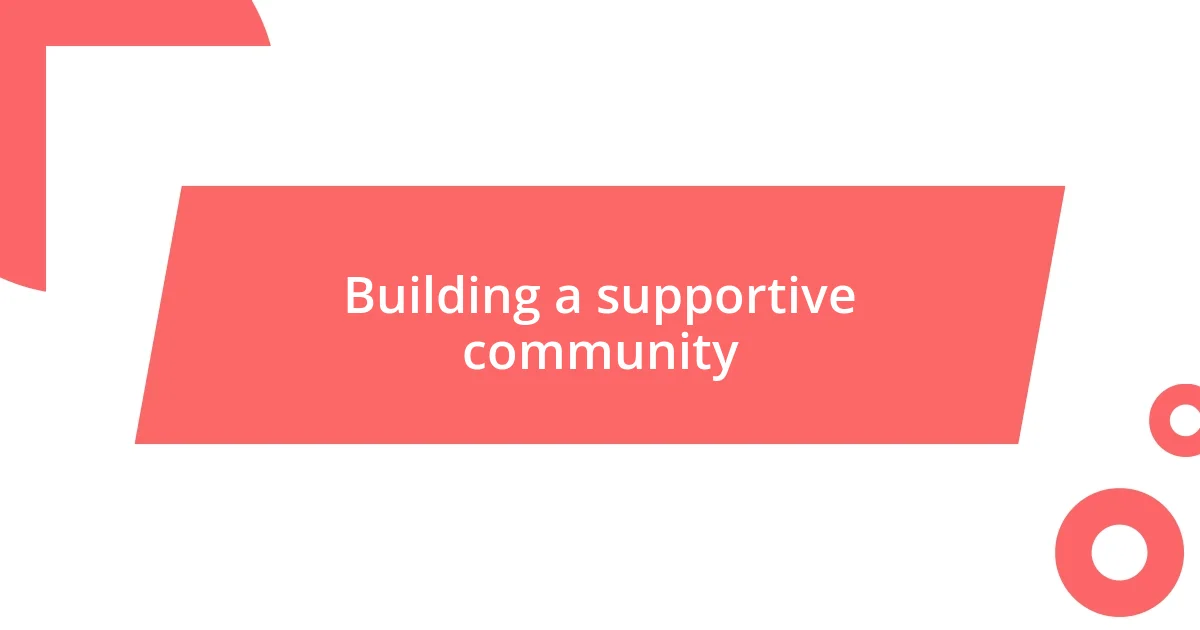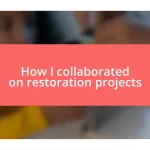Key takeaways:
- Environmental advocacy transforms personal passion into collective action, highlighting the interconnectedness of community efforts and individual responsibility.
- Building a supportive community is essential; sharing experiences fosters empathy and amplifies advocacy efforts through collaboration and dialogue.
- Utilizing social media effectively can enhance awareness and engage a larger audience, turning individual actions into a broader movement for change.

Understanding environmental advocacy
Environmental advocacy isn’t just about voicing concerns; it’s about channeling passion into action. I still remember the first time I stood before a gathering, urging others to consider the impact of plastic waste. The energy in that room—an exhilarating mix of uncertainty and hope—reminded me of the collective strength we hold when we unite for a common cause. Isn’t it incredible how one person’s determination can spark a movement?
When I began exploring this path, I realized that environmental advocacy encompasses various approaches, from grassroots activism to policy reform. I felt a deep sense of responsibility as I learned about the injustices faced by marginalized communities affected by pollution. Why should the most vulnerable bear the brunt of environmental destruction? These moments ignited a fire in me, pushing me toward activism that felt both personal and globally significant.
It’s fascinating to see how environmental advocacy can be a gateway to deeper conversations about justice, sustainability, and our collective future. I’ve often found myself in discussions with friends, pondering how our daily choices impact the planet. Each conversation was a reminder that advocacy begins with awareness, and I often ask myself: How can I inspire others to recognize their role in this vast web of life? Understanding this interconnectedness has been essential to my journey, transforming my passion into purpose.

My personal motivation journey
My journey as an environmental advocate truly began on a crisp autumn morning while hiking in my favorite national park. As I stood atop a hill, gazing at the vibrant colors of the leaves, I realized how fragile our natural spaces are. I recalled seeing litter scattered along the trails in the past, and it struck me how my love for nature spurred a commitment to protect it. The beauty of that moment was profound, propelling me to become a voice for change.
- Inspired by outdoor adventures and the beauty of nature.
- Witnessed firsthand the negative effects of litter and pollution.
- Realized my passion for the environment requires action and advocacy.
I can vividly remember a conversation with a close friend who dismissed recycling as a futile effort. My heart sank as I engaged him in a passionate debate, sharing facts about landfill overflow and ocean pollution. His eventual nod of understanding felt like a small victory. It wasn’t just about changing one person’s mind; it was about cultivating a mindset within my circle that resonated with eco-consciousness. That day reminded me of the ripple effect of personal storytelling and how sharing experiences builds empathy and motivates collective action.

Gaining knowledge about environmental issues
Gaining knowledge about environmental issues is a journey marked by exploration and personal discovery. I still remember the first documentary I watched on climate change—it stirred something deep inside me. The images were haunting and the statistics staggering. I found myself reflecting on everything I knew, or rather what I thought I knew, about the environment. My thirst for facts pushed me to seek out books, podcasts, and articles that inspired me to dig deeper. What intrigued me most was connecting the dots between my lifestyle choices and their impacts on the planet.
In my quest for understanding, I discovered that local knowledge plays a crucial role. I began attending community meetings where environmental policies were discussed. Hearing from activists and scientists firsthand opened my eyes to the real-world implications of environmental degradation. I was struck by how interconnected our stories are—one person’s experience with pollution could mirror the struggles of countless others. This connection reinforced my belief that knowledge isn’t just about facts. It’s about emotions and experiences shared within our communities and across the globe.
Looking back, it’s clear that every piece of knowledge I gained had a ripple effect on my advocacy. The more I learned, the stronger my resolve grew. I became motivated to share what I discovered with those around me. Have you ever felt compelled to educate someone on an important issue? That’s what it felt like for me, a commitment to illuminate the path for others, driven by the real impact that knowledge can have on our collective future.
| Methods of Gaining Knowledge | Benefits |
|---|---|
| Documentaries | Visually impactful, raises awareness |
| Community meetings | Fosters connections and shared experiences |
| Books and podcasts | In-depth knowledge and expert opinions |

Building a supportive community
Building a supportive community is essential to any advocacy journey. I’ll never forget the warmth of my first volunteer event at a local beach cleanup. Surrounded by enthusiastic strangers, I felt an immediate sense of belonging. We exchanged stories, laughter, and shared our personal reasons for being there. Witnessing their dedication fueled my commitment; it was like we were weaving an invisible thread of solidarity for a common cause.
As I engaged more with fellow advocates, I started recognizing the power of collaboration. I organized a small discussion group where everyone could voice their concerns and ideas—some shared experiences that moved me profoundly. Have you ever listened to someone express a struggle you didn’t know existed? That day, I realized how vital it is to create spaces for open dialogue. The genuine connections we form amplify our voices; they turn individual efforts into a unified front for change.
Through social media, I tapped into online communities that echoed my passion. One evening, a member shared a heartbreaking story about their community facing pollution from a nearby factory. Instantly, I felt the urgency to respond, not just with sympathy, but with actionable support. These interactions remind me that advocacy extends beyond geographical boundaries. When we uplift one another’s narratives, we foster a network that empowers each of us to advocate more effectively. Isn’t it powerful to think that our shared experiences can drive collective action?

Engaging in local initiatives
Engaging in local initiatives is where advocacy truly comes to life. I remember my excitement when I joined a local tree-planting event; there’s something magical about digging your hands in the soil alongside new friends, sharing laughter while contributing to a healthier community. Did you ever plant something and feel a sudden connection to the earth? I did, and it sparked a deeper appreciation for the natural spaces around us.
Participating in initiatives like community gardens or recycling drives opened my eyes to how local actions can create significant ripples. One weekend, I volunteered for a neighborhood clean-up and saw firsthand what litter does to our parks. The collective effort of our small group made a tangible difference, but more importantly, it ignited conversations with neighbors about waste management and sustainability. I walked away with new ideas and friendships, realizing that change often begins in our backyards.
Through local initiatives, I discovered the power of grassroots movements. I recall attending a town hall meeting, where passionate residents voiced their concerns about a proposed development threatening a nearby wetland. Their stories echoed in my mind long after leaving. It underscored a vital lesson: when we engage as a community, our combined voices give strength to the cause. Don’t you think that local action can inspire bigger change? I truly believe it can, one step at a time.

Utilizing social media for awareness
Utilizing social media for awareness has been a game-changer in my advocacy journey. I vividly recall the day I shared a post about the impact of plastic pollution, and within hours, friends began tagging each other, sparking conversations in the comments. It struck me how a single post could amplify concern and ignite discussion among people who might never have connected otherwise. Have you ever felt the energy shift when a topic resonates with others? That connection is what drives me to continue sharing.
As my following grew, so did my responsibility to share reliable information—a lesson I learned the hard way when I unknowingly posted an unverified statistic. Despite my initial embarrassment, I turned it into a learning opportunity. I gained a deeper appreciation for fact-checking and the importance of using credible sources. The engagement from my audience was phenomenal; they began to ask questions and share their insights, forming a virtual think tank around environmental issues. Isn’t it incredible how mistakes can foster growth and dialogue?
One of my proudest moments came when I initiated a challenge for my followers to reduce single-use plastics for a month. I created a hashtag and encouraged everyone to share their progress, resulting in a flurry of creative, inspiring posts. Just reading each story about how someone swapped out plastic bags for reusable ones or discovered alternative products made me feel part of something larger than myself. It was a reminder that social media, if used wisely, can turn individual actions into a wave of awareness and change. How else could we inspire each other to take such meaningful steps? I’ve learned that these digital platforms hold the potential to build a movement, one post at a time.

Tips for aspiring advocates
Networking with other advocates is essential for aspiring environmentalists. I still remember attending my first environmental conference, feeling both nervous and excited. The moment I began chatting with seasoned advocates, I realized how open and willing they were to share their experiences. Have you ever felt that rush of inspiration when you connect with like-minded individuals? For me, those interactions not only expanded my knowledge but also provided a sense of belonging in the advocacy community.
Another key tip is to stay informed about current environmental issues. Regularly reading blogs, following environmental journals, and subscribing to newsletters can help you stay updated. I often carve out a bit of time each week to read reports or listen to podcasts on climate change and conservation topics. This practice not only empowers me with information but also fuels my passion. What’s your go-to source for staying informed? Finding reliable resources can make all the difference in your advocacy efforts.
Lastly, never underestimate the importance of self-care. Advocacy can be overwhelming, and it’s easy to feel discouraged, especially when faced with daunting challenges. I’ve had my share of tough days, where the weight of the world seemed too heavy. But I learned to take breaks and recharge by hiking or simply enjoying a quiet moment in nature. How do you rejuvenate after a long week of advocating? A refreshed mind and heart often lead to renewed passion and creativity, ensuring you can continue your important work with enthusiasm and resilience.















